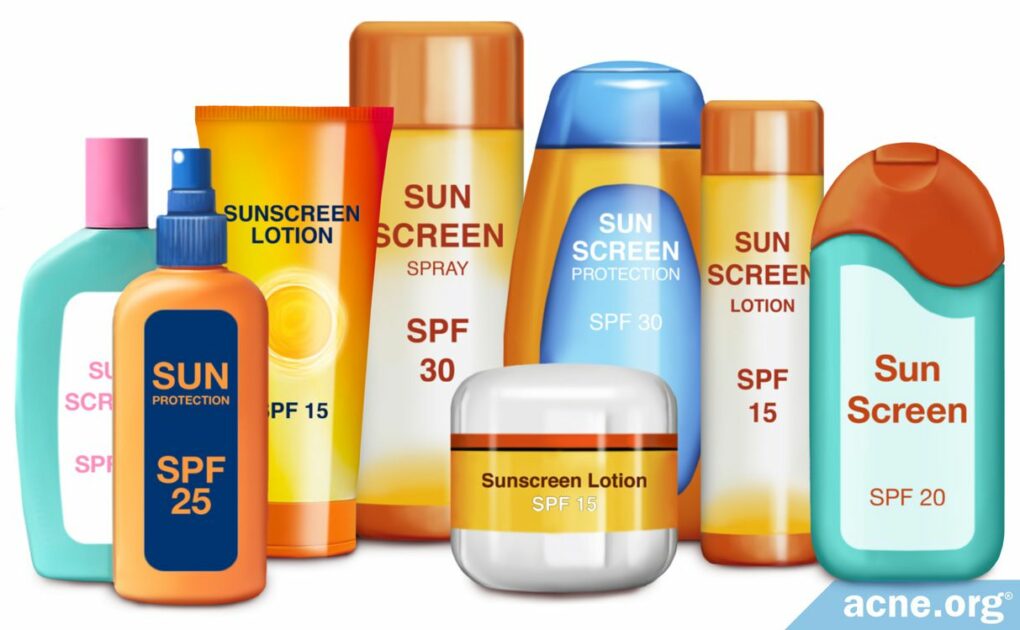Using Sunscreen (SPF) on Acne-prone Skin

The Essential Info
A healthy amount of sun exposure can be beneficial for the body and the skin. Unprotected sun exposure to bare skin is the main way our bodies produce vitamin D, an important nutrient. However, over-exposure, particularly sunburn, causes skin damage and can result in breakouts in the weeks following over-exposure. Since it’s not always easy to limit exposure, an effective, non-pore-clogging sunscreen is an important part of a proper skin care routine.
There are many sunscreens on the market and some of could potentially break you out. This is why it’s important to choose wisely by:
- Choosing a broad-spectrum SPF factor of 15-30: An SPF 15 may be less likely to break out the skin, and provides almost as much protection as an SPF 30 (these numbers are not linear), so this may be the way to go. However, some carefully formulated higher-SPF products may also be safe. Always choose a “broad-spectrum” sunscreen so you are protected from both UVA and UVB rays.
- Looking for the term “non-comedogenic” or “for acne-prone skin” on the label: While these terms are unregulated, we can at least hope that the manufacturer is thinking about acne as an issue. Did they test their products accordingly? That we don’t know.
- Choosing large, brand-name products marketed toward a younger demographic: There are always exceptions, but as a whole, drugstore products marketed toward teens and young adults are formulating for more oily skin, whereas department store products marketed toward older people put an emphasis on emollience for older, dryer skin, and some greasy emollients can clog pores.
- Making sure pore-clogging ingredients aren’t in the top seven (7) listed on the ingredients list: Check ingredients against this list.
Applying the right way and the right amount: Because physical irritation of the skin can aggravate acne, use a featherlight touch when applying sunscreen to acne-prone areas of your face or body. 1/4-1/3 teaspoon is enough for the face, and 1 full ounce is recommended for the body. Reapply every 2 hours (total) that you are in the sun since sun degrades sunscreen ingredients.
Are they safe? While wearing sunscreen limits the body’s ability to produce vitamin D and can also produce free-radicals when the sun’s UV rays interact with sunscreen ingredients, but most experts agree that the benefits of wearing sunscreen outweigh the risks.
From Dan: People always ask me which sunscreen I use. I’m not completely happy with any of them, but the one I use is Banana Boat Sport Performance Active Dry Protect SPF 15, Very Water/Sweat Resistant*. That’s a mouthful. But I give it a thumbs up in most ways and doesn’t seem to give me a big problem with breakouts. *Acne.org is not associated with Banana Boat in any way.

The Science
- Physical SPF vs. Chemical SPF
- Broad-Spectrum
- SPF (Sun Protection Factor) Number
- How to Apply
- Water Resistance
- Downsides
- Using Sunscreen with The Regimen
Getting unprotected sunlight on the skin is the way our bodies make vitamin D, an important nutrient in the body that when depleted, might potentially lead to more acne. So getting a little sun is not necessarily a bad thing. People with the lightest skin can get up to 20 minutes per day of unprotected sun exposure, and people with the darkest skin can get 2 hours. However, the skin can only take so much, and over-exposure to the sun will end up damaging the skin. Sunburns can bite back with acne in the weeks following exposure as the skin heals, so if you notice a breakout seemingly coming out of nowhere, especially in the summer months, ask yourself if you got sunburnt 1-2 weeks ago. That may be the cause. To put it succinctly, don’t be afraid of the sun but try not to get burnt.
A good sunscreen can help prevent sunburn, but finding a safe and protective sunscreen can be challenging. Here’s some information to help you choose wisely.
Physical SPF vs. Chemical SPF
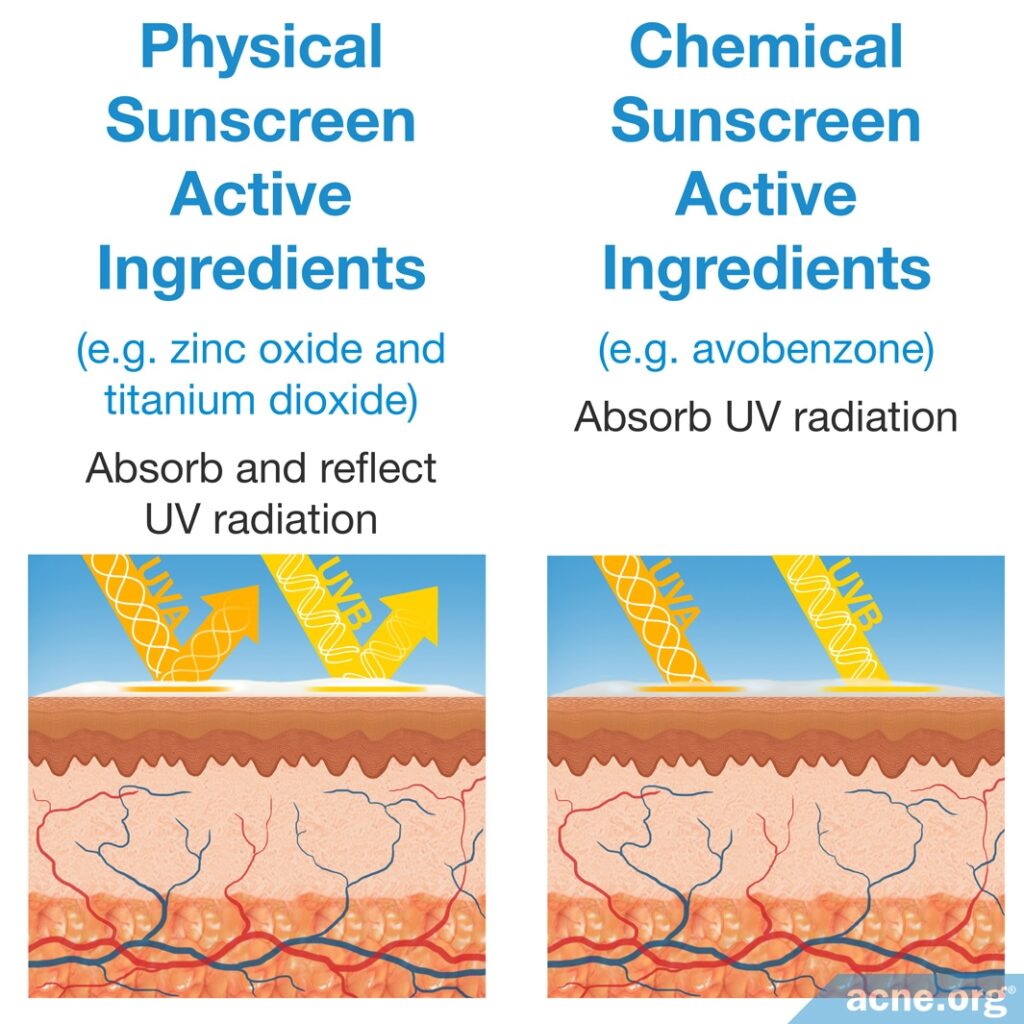
There are two types of sunscreens, physical and chemical.
Physical sunscreens: Physical sunscreens absorb but also reflect or block the sun’s rays. There are two physical sunscreens: zinc oxide and titanium dioxide. Zinc oxide is the gentler of the two and offers superior sun protection. Physical sunscreens tend not to clog pores and stay effective all day long, no matter how long you are in the sun. However, products with physical sunscreens are drying to the skin, and due to the physical nature of zinc oxide and titanium dioxide, most brands go on white and leave the skin looking pale.
Chemical sunscreens: Chemical sunscreens absorb the sun’s rays. There are numerous chemical sunscreen ingredients on the market. They tend to have a less reliable record with acne-prone skin and must be judged product-by-product to determine whether they are safe to use. Some chemical sunscreen products are perfectly safe for acne-prone skin, while others tend to break people out. Chemical sunscreens begin degrading once they are exposed to sunlight and are effective for 2 hours of sun exposure. However, they go on clear, and tend to be moisturizing.
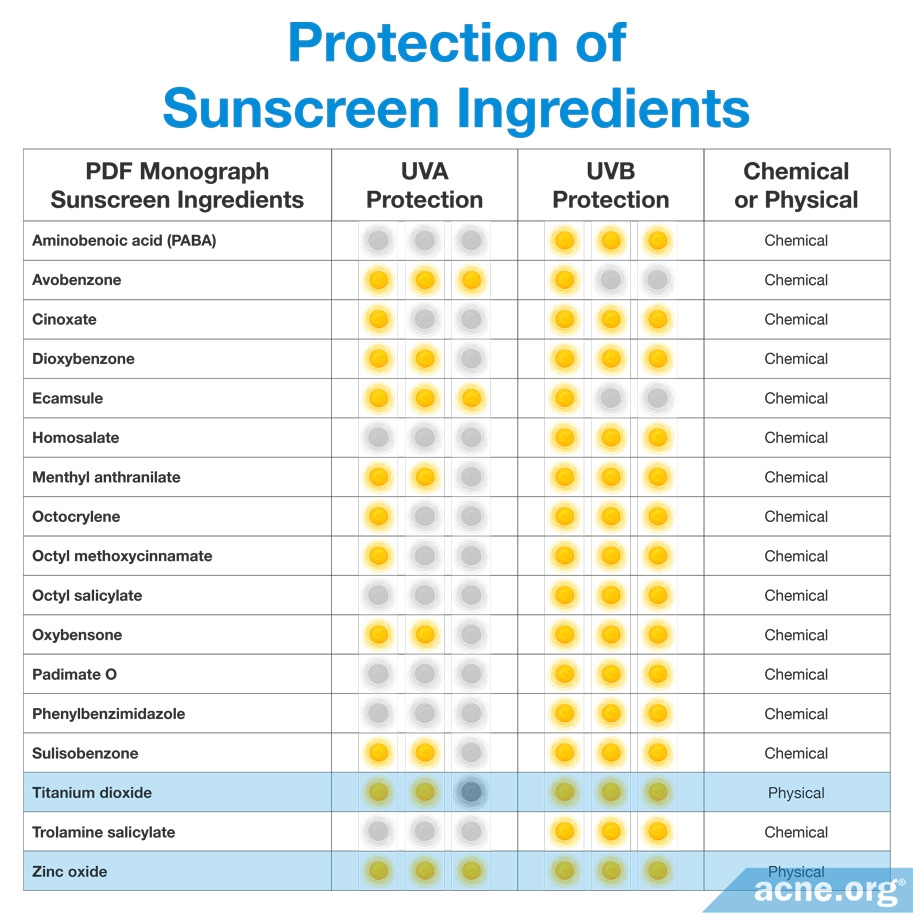
Broad-Spectrum
The term broad-spectrum applies to sunscreens which block both UVA and UVB rays. UVB rays are the rays responsible for tanning or burning the skin. Both UVA and UVB rays are responsible for skin damage, premature aging, and cancer. Both zinc oxide and titanium dioxide are broad-spectrum, with zinc oxide being the superior of the two. There are few fully effective UVA chemical sunscreens, with the notable exceptions of Avobenzone and Ecamsule, which provide full UVA support.
SPF (Sun Protection Factor) Number
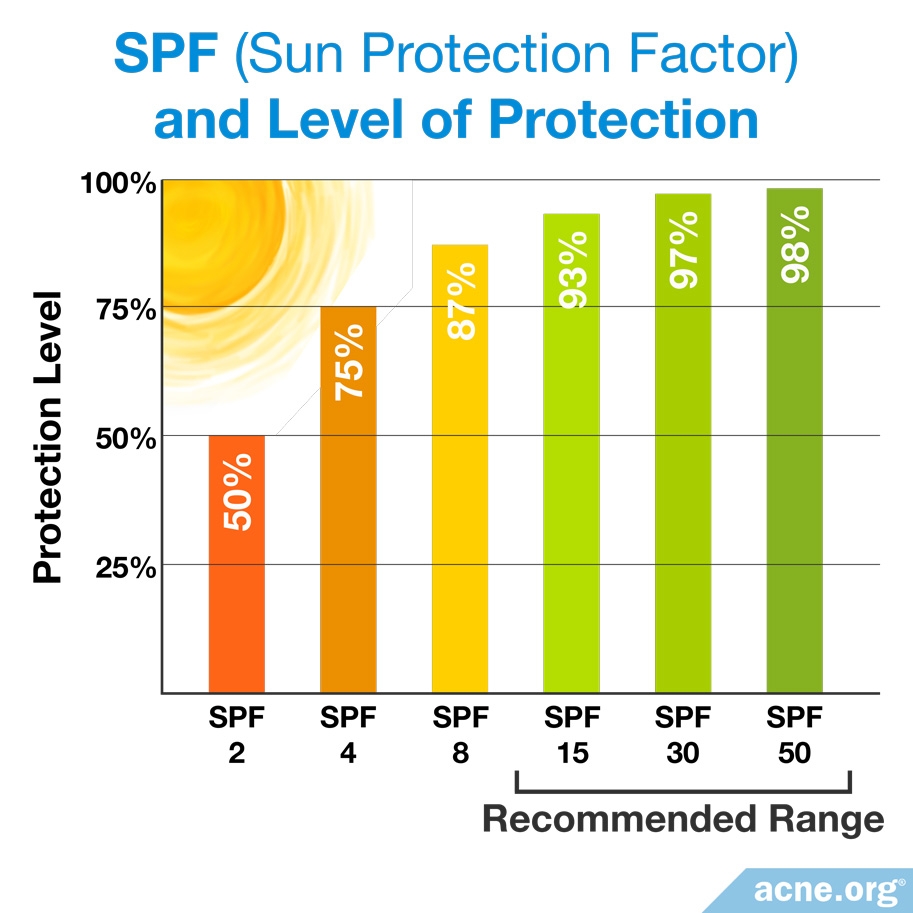
The SPF number on a sunscreen refers to only UVB blocking. The higher the number, the longer you can stay in the sun without burning. The SPF number is a multiplier. If you normally burn in 30 minutes, an SPF of 2 will allow you to stay in the sun for 60 minutes without burning. An SPF of 3 will allow you to stay in the sun for 90 minutes, an SPF of 4 for 2 hours, and so on. An SPF of 15 would take this time up to 7 ½ hours.
Another way to look at the SPF number is by the amount of UVB rays that are blocked. An SPF of 2 blocks about 50% of these rays. An SPF of 15 blocks 93%, and an SPF of 30 blocks 97%. Most authorities recommend an SPF of 15 or greater. Nothing provides 100% support, and the higher the number, the more likely the product will be drying (physical) or greasy (chemical).
How to Apply
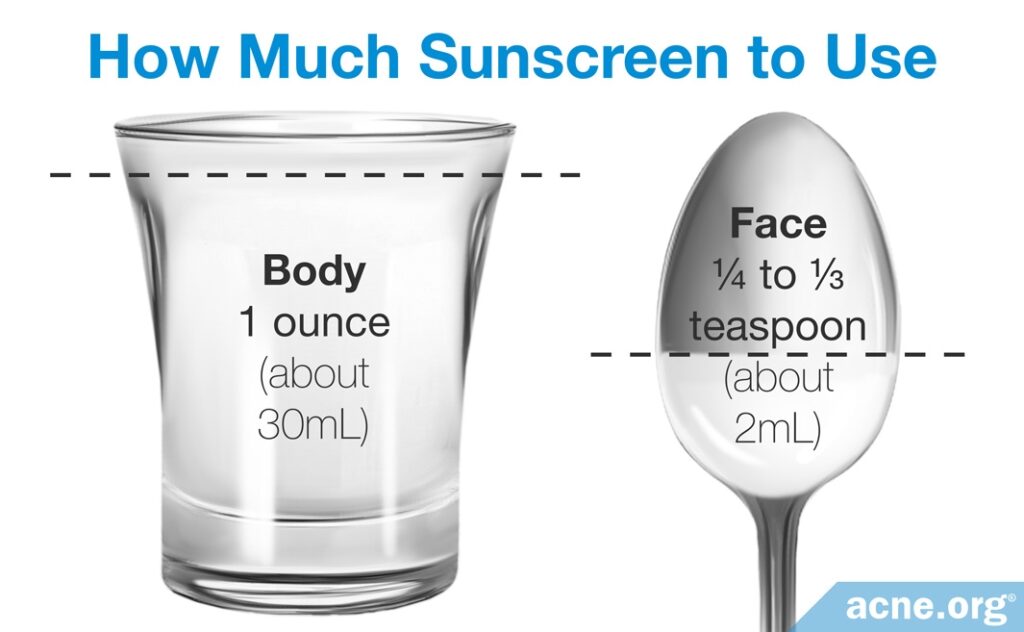
How much. To get the full protection advertised on the label you must apply an adequate amount of sunscreen. This equates to a full 1 ounce (30mL) – a shot glass worth – for the average 150 pound person’s entire body, or ¼ to ⅓ teaspoon (about 2mL) for your face. Most people apply much less than is recommended and on average are only getting ¼ the protection the product claims. Once you have the right amount dispensed, apply it very gently as you would moisturizer to avoid irritation.
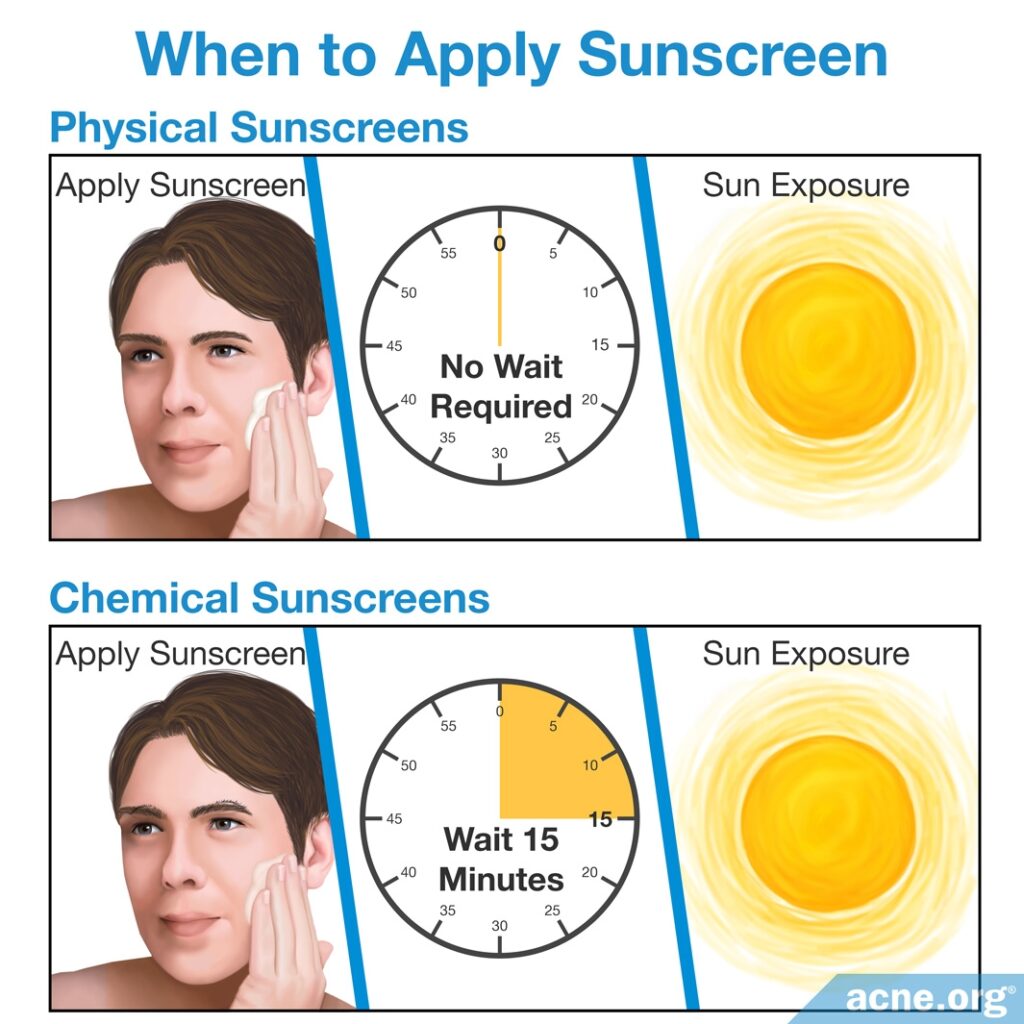
When. If applying a physical sunscreen such as zinc oxide or titanium dioxide, you can apply it immediately before sun exposure. Physical sunscreens begin protecting the skin immediately after application. Chemical sunscreens are made to be applied 15 minutes before sun exposure since they need to “kick in” and require 15 minutes before they provide maximum protection.
How often. Physical sunscreens need to be reapplied only if you get wet, sweat a lot, or towel dry. Otherwise, they are good all day. Chemical sunscreens begin degrading when exposed to sunlight and last only 2 hours in the sun. If you apply a chemical sunscreen in the morning and get less than 2 hours of sun throughout the day, you’re all set. However, if you’re going to be in the sun all day, you will need to reapply every 2 hours, or after you get wet, sweat a lot, or towel dry.
Water Resistance
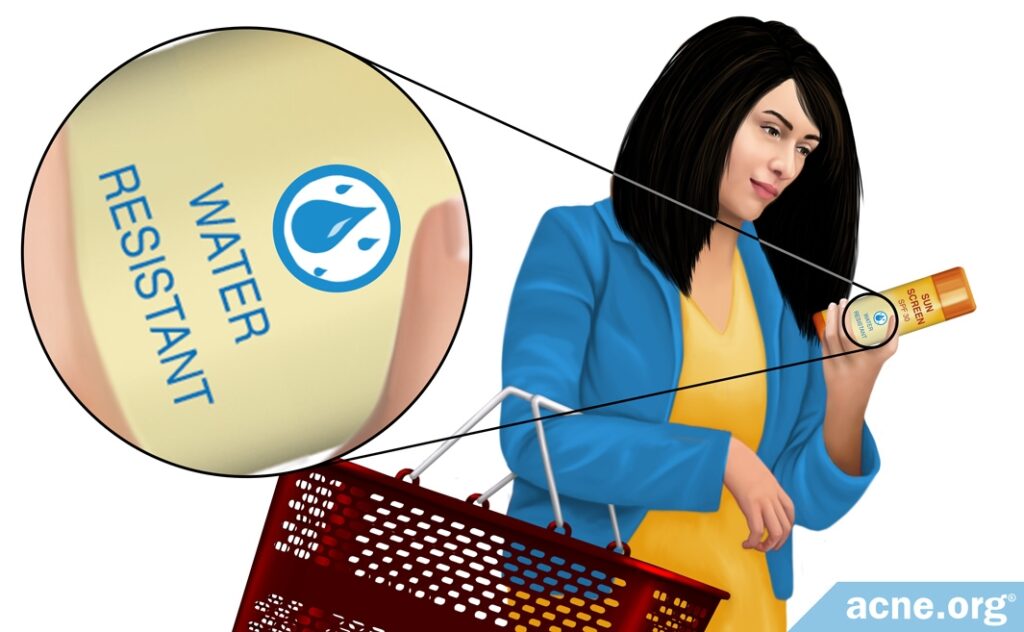
Sunscreens which claim “water-resistant,” “very water-resistant,” or “waterproof” include ingredients which create a water repellant layer on top of the skin. While convenient, water-resistant products can be irritating to acne-prone skin. Also, because water-resistant sunscreens are specifically formulated to be difficult to wash off, this creates unnecessary irritation when attempting to remove the sunscreen, which can further aggravate acne.
Downsides
Applying an SPF as low as 8 will reduce your body’s ability to make Vitamin D by 95%. Vitamin D is an essential nutrient and a startling amount of people are deficient. The sun is not evil. 20 minutes of unprotected exposure per day for people with light skin, and 30 minutes per day for people with darker skin will provide healthy levels of vitamin D. If you are always wearing SPF, ask your doctor to check your vitamin D level and consider taking a vitamin D supplement. Look specifically for vitamin D3.
Sunscreen also releases free radicals into the skin. However, damage from sun’s rays does the same thing, and the FDA and AAD (American Academy of Dermatology) both agree that the benefits of sunscreen outweigh the risks.
Using Sunscreen with The Regimen
The Regimen, which is a 3-step routine that reliably clears the skin, requires the use of benzoyl peroxide, which is a drying and peeling agent. In order to stay acne-free, it is important to get the skin back into moisture balance after applying benzoyl peroxide. Physical sunscreens, while not pore-clogging in themselves, tend to be intensely drying. Most people find that applying zinc oxide or titanium dioxide based sunscreens simply leaves the skin too dry and flaky after benzoyl peroxide.
From Dan: My sunscreen of choice currently is Banana Boat Sport Performance Active Dry Protect SPF 15, Very Water/Sweat Resistant*. That’s a mouthful. But it is a chemical sunscreen so it I can avoid the whitening and drying of zinc oxide or titanium dioxide sunscreens, and it doesn’t seem to give me a big problem with breakouts, plus I give it a thumbs up for staying put throughout the day and not stinging my eyes too bad. *Acne.org is not associated with Banana Boat in any way.
 Acne.org Products
Acne.org Products